 artist John Glashan (1927-1999) drew a complicated and unique weekly cartoon in the UK’s Observer magazine titled Genius between 1978 and ’83. In the introduction to the collection John Glashan's World published in 1991 he wrote “It occurred to me that the cartoon form had the potential for something wider-ranging than the three patterns in current usage: the political cartoon, the single joke, the strip cartoon.” I like this because he apparently saw the American comic book and its ambition to become the 'graphic novel' as a separate and unrelated event, a different medium even (as I do). Alternatively it had not impinged on his consciousness at all, which would be difficult to imagine of a cartoonist in the UK in 1991 as the newspapers were full of it, but I prefer to think that he simply wasn't impressed.
artist John Glashan (1927-1999) drew a complicated and unique weekly cartoon in the UK’s Observer magazine titled Genius between 1978 and ’83. In the introduction to the collection John Glashan's World published in 1991 he wrote “It occurred to me that the cartoon form had the potential for something wider-ranging than the three patterns in current usage: the political cartoon, the single joke, the strip cartoon.” I like this because he apparently saw the American comic book and its ambition to become the 'graphic novel' as a separate and unrelated event, a different medium even (as I do). Alternatively it had not impinged on his consciousness at all, which would be difficult to imagine of a cartoonist in the UK in 1991 as the newspapers were full of it, but I prefer to think that he simply wasn't impressed.The problem with this book is that it doesn't do his higher concept justice, arranged as it is in the manner of conventional cartoon books under thematic headings such as 'money,' 'guilt,' 'love,' fame.' Any reader attuned to the bigger idea would have preferred the pages run in the order the artist made them, and with the goddamn dates attached. But book publishers have never been good at understanding bigger ideas, at least in relation to cartoons, and they still (with few exceptions) do not get them, as I have found in my recent forays into the book world.
But most of my readers are probably not familiar with Glashan and his work. His wikipedia entry will bring you up to scratch, and since i am not being paid to write this blog, I will simply steal it without paraphrase: " Scottish cartoonist, illustrator, and playwright, creator of "Genius". Glashan's cartoons typically included small pen-and-ink figures drawn over a fabulous backdrop often featuring fantastic (Gothic/imaginary) architecture, surreal landscapes, or gloriously impractical ingenious-looking machines. Born in Glasgow and the son of a portrait painter, McGlashan studied painting at the Glasgow School of Art after national service in the army. He moved to London with the intention of making a living from painting portraits, but was unable to do so. Switching to cartooning and illustrating, he curtailed his name to "Glashan". Glashan's cartoons appeared in Lilliput, Harpers & Queen, Private Eye, Punch, and various London newspapers, as well as Holiday and the New Yorker. A series of humorous guidebooks created with Jonathan Routh in the late 1960s allowed extensive expression of Glashan's graffiti-like style, combining small figures (often bearded men) with scrawled text -- but even here, often with elaborate backdrops. In 1978 he took over Jules Feiffer's spot on The Observer magazine and began his strip cartoon Genius featuring Anode Enzyme (IQ 12,794) and his patron Lord Doberman, the richest man in the world. 'Genius' won him the Glen Grant Strip Cartoon award in 1981. This ran until 1983 when he returned to landscape and portrait painting, and from 1988 to 1998 he also contributed weekly cartoons to The Spectator."
Here are a couple of examples of the weekly series, featuring the aforementioned characters Anode Enzyme and Lord Doberman (dates as I said irritably, are unknown to me, though I imagine there must be somebody who collected the stuff as it came out). Another problem with the book is that the things are printed too damn small, two to a page. As I recall, the Observer didn't do them any favours either. They clearly come from the tradition of the gag a day strip cartoon; once the set-up had been established, with a minimum of narrative introduction, the work was an ongoing series of self-contained variations and elaborations. Glashan's sense of a bigger kind of strip cartoon was all about scale. Each of his pieces wants at the very least a full magazine sized page. There's one place in the book where a single painted gag cartoon, not involving any regular characters, is given a double page spread and the watercolours are a joyful ocular experience. Why couldn't it all have been thus? It's no wonder he got out of the business and made a living from his painting. The larger end of his scalar contrast was usually a baronial hall or some baroque improbability:

But in this one he switches it around and an easel painting of a fish is dwarfing his cast of characters:

There is much aesthetic pleasure to be had in looking at the contrast of the typical big painterly image with the sensitive tiny pen drawings. here's a zoom on one of the latter:

The grand scale was also reflected in the characters and the relationships between them. "Anode Enzyme is a genius with an IQ of 12,794. Master of all trades, Jack of none; his impeccable psychic architecture is marred by a single flaw- he has no money." He becomes employed by Lord Doberman, richest man in the world. In a sequence running over several weeks, the first task that is given to the genius is to invent a machine that will fire portable television sets into the sea. "What rate of fire?" asks the genius without hesitation. "Twenty sets per minute," responds Doberman, equally without hesitation.
there's a website
Labels: classic strips(2), classic strips(3), old books (2)
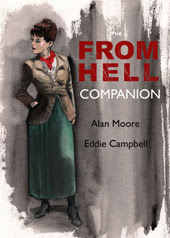


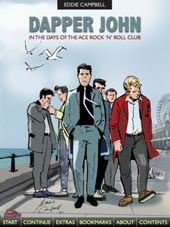
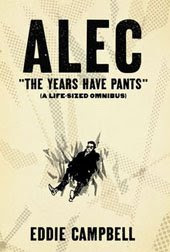
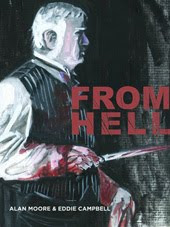
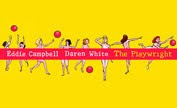
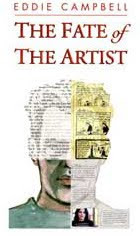
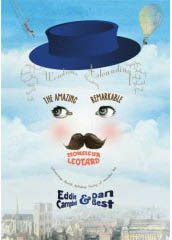





9 Comments:
On the site he is quoted as saying 'I have discovered that the nearer humour approaches seriousness, the funnier it will be. Being funny is not funny. Humour is seriousness in disguise'.
He was a very smart man, and reminds me of Jules Feiffer. Thanks for pointing him out.
Thank you for mentioning this great artist. I love his beautiful watercolors! Thanks- Geri
Thanks for alerting me to this new compilation. Growing up in the US, my sole exposure to Glashan was a compilation called "Speak Up You Tiny Fool" which my folks had in amongst the New Yorker/Chas Addams books. One drawing in that book had the caption "Away, badly-drawn bird!" and I've often wondered if that was the inspiration for the UK singer-songwriter Badly-Drawn Boy. He also seemed to have a certain love for drawing technology - trolley cars, space capsules, etc. Visually, I suppose his work was a bit like that of Jean-Jacques Sempé - deceptively simple and "loose", but with fantastic drawing skills underneath. But where Sempé went for cozy sentimentality, Glashan's vision was cynical and acidic. My favorite sequence involved a playwright who mounted a huge epic, with a cast of thousands, gigantic sets, etc. only to have his entire cast walk off because the show premiered on the day that welfare checks were delivered!
Dan,
Sorry, I should be clearer. old book, not new. I probably talk more about old ones here than new, so I forget to say.
Eddie
Whoops! That's what I get for not reading carefully. But I see that copies of the book can be found, so you've still performed a valuable service.
Dan,
I should have said also that i only recently got my own copy second hand via Amazon after seeing my pal mr j with one. I just had to have it.
hope you get hold of one easily
best
eddie
Astoundingly beautiful work, thanks for alerting us to it!
I found it through Alibris (at a reasonable price) and received it in today's mail. It's a revelation to see some of his dense, architecture-filled stuff in color. Thanks again for the tip!
I recently discovered Glashan for myself, and now I have 3 books of his. John Glashan's World is nice, and worth buying for the introduction alone. But I think the Penguin John Glashan is far funnier. The Private Eye collection is excellent value - you can pick it up for under a fiver, and it features the amazing extended sequence of the Meths Festival in the "sleepy pig iron town" of "Grinding Mallet". Glashan's humour for me consists in making fun of things that most people would rather not think about: poverty, alcoholism, the wealth divide etc. If only more cartoonists would take heed of his maxim that "the more humour approaches seriousness, the funnier it will be". Great stuff.
Post a Comment
Subscribe to Post Comments [Atom]
<< Home